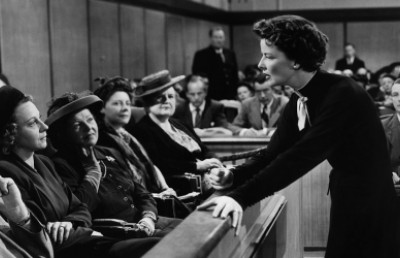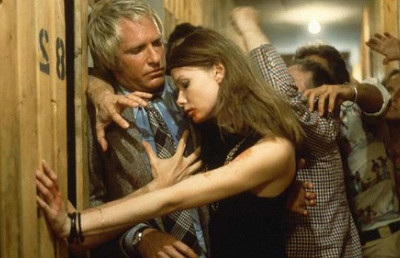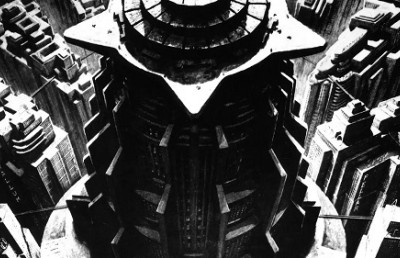Mockumentary in the Hands of Peter Watkins
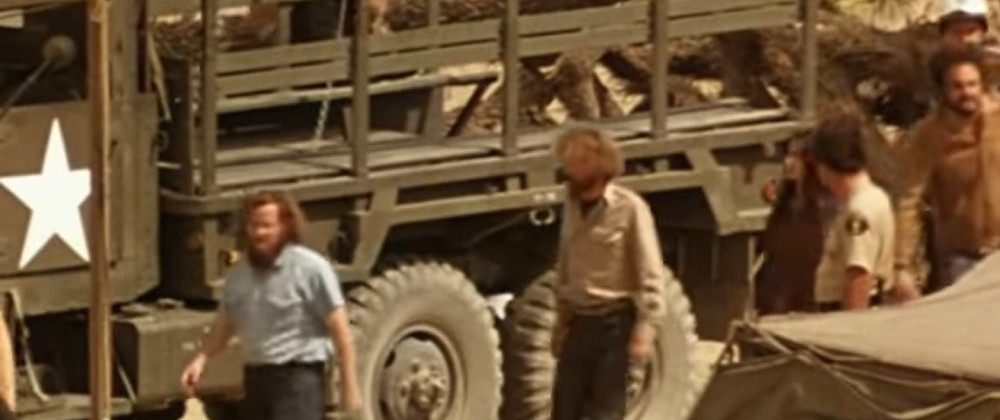
British filmmaker and media theorist Peter Watkins (1935-) was no stranger to political filmmaking and the strategy of reconstructing actual events using a faux-documentary style. His first short film, The Web (Watkins, 1956), was a reconstruction of events that took place in France during the Second World War, while his most popular short film, The Forgotten Faces (Watkins, 1961), which earned him critical acclaim and awards, is a reconstruction of the 1956 Hungarian revolution. His first feature-length film, Culloden (Watkins, 1964), was a recreation of a brutal battle that took place in Great Britain during 1746. This film was similar in style and content to Punishment Park (Watkins, 1971), as it aimed to criticize those in power for allowing such a horrible battle to take place. Watkins conveys this by employing the same mockumentary style and off-camera voice-over that we hear in Punishment Park (which he voiced himself, which can be seen as a connecting force between his films). It is this use of a ‘post-documentary’ form that granted him the title of “the father of the modern docudrama” according to some film theorists (Cook, 228).
This essay will deconstruct and examine how Peter Watkins used his mockumentary films as a form of activism by using the filmmaking process as a way of protesting against the Hollywood system. In particular, looking at how he would use future timelines as a warning for where society is heading, as well as the ironic backlash against the film, which led to it being silenced, and ultimately making the film’s critique a self-fulfilling prophecy.
Watkins Himself
Peter Watkins, who remained active from the 60s through the 90s, was a controversial figure within the film industry. He took issue with the Hollywood production methods and stayed faithful to his “theoretical principles which he had formulated to be deliberately oppositional to mainstream, established filmmaking” (Ibid., 228). He would do this by making films that merged dramatic performances with a documentary or vérité shooting style that would mimic the sort of urgency and authenticity normally found in documentary films. Because of this, his films felt similar to television newsreels (Ibid., 228).
This desire that Watkins had to go against “what he felt to be the ‘falseness’ of Hollywood in the dramatic representation of reality”, was a common belief among the movement of young ‘amateur’ British filmmakers of the time (Ken Russell, Kevin Brownlow, John Schlesinger), especially when it came to the portrayal of war and conflict (Ibid., 229). However, Watkins stood out because he refused to compromise his vision and what he thought to be his ethical working style for the studio heads. He would go as far as to sabotage his own studio deals, like the time he was asked to remake his anti-nuclear war film The War Game (Watkins, 1966). He had accepted a modest budget and then used that budget to further the cause by developing new anti-nuclear warfare organizations. This raised the budget of the film so far beyond what he accepted that the studio dropped the project (MacDonald, 33).
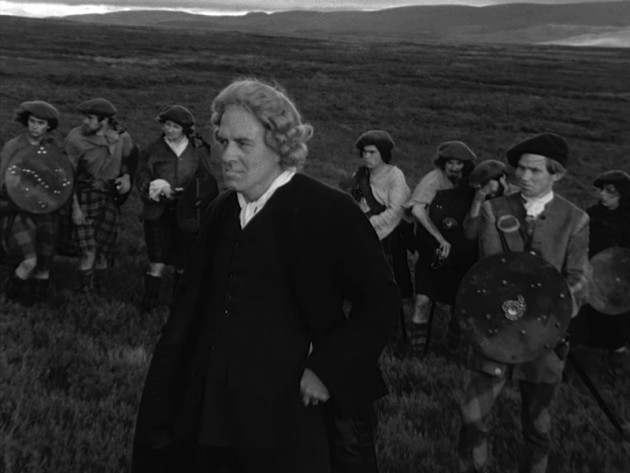
Culloden
Although he never claimed his mockumentary films were true documentaries in that they have no essence of fiction at their core, they were made to feel realistic, even if not being faithful to the time period. A specific reference point would be his first feature-length film Culloden, in which we follow a camera crew documenting a battle that takes place in the year 1746. Certainly, it makes no sense for a documentary crew to be anywhere in 1746, but Watkins plays this completely straight as we see interviews with soldiers and generals that are fighting the battle. It is the seriousness with which he treats the subject through this mockumentary lens that implies that the film is taking place in an alternate reality/timeline in which a documentary crew could be sent back in time to film such an event. Peter Watkins uses the mockumentary form in order to question those in power and hopefully convince the oppressed to become more active against their oppressors.
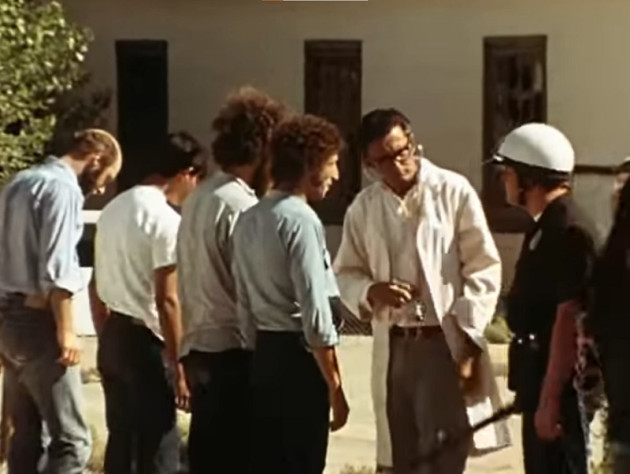
Getting the prisoners ready for transport
To ensure his message got across Watkins would go to painstaking efforts to make his films look as authentic as possible. An example being his short film The Forgotten Faces, in which his team researched hundreds of photographs from the time the event took place and matched their actors’ costumes and makeup to look as close to the actual people as possible. This authenticity seemed to work since many viewers mistook it as documentary rather than a recreation (Cook, 229). This was also helped by the fact that Watkins would use non-professional actors (Watkins preferred the term ‘non-actors’) whenever he could (Cook, 231). He much preferred authenticity over dramatic value which is why he cast social actors who had experience with the actual struggles the characters were going through (Cook, 232).
Punishment Park
Punishment Park, directed by Peter Watkins and released in 1971, follows a documentary crew as they track the events that take place within “Punishment Park,” a correctional facility in the middle of the southern California desert. The desert becomes the backdrop for a “most dangerous game alive” scenario where prisoners, mostly young activists, are given the choice to either serve their full sentence in prison or attempt a stint in the park that could lead to their release. This attempt would involve them having to run through the desert for four days to reach an American flag that has been placed 53 miles within the desert, while simultaneously being hunted by the police. If they reach the flag they get released and reclaim their “freedom”, but if they fail they must carry out their entire prison sentence. We are shown their trials which involve arguments between the detained and the tribunal in which the conservative court refuses to listen and also knowingly goes against the constitution. All of the prisoners choose to take their chances in the park, rather than immediately be sent to prison. By the end of the film, we see that the system is fully rigged and all of the participants are either murdered or captured when they are greeted by an army of police officers waiting for them at the American flag.
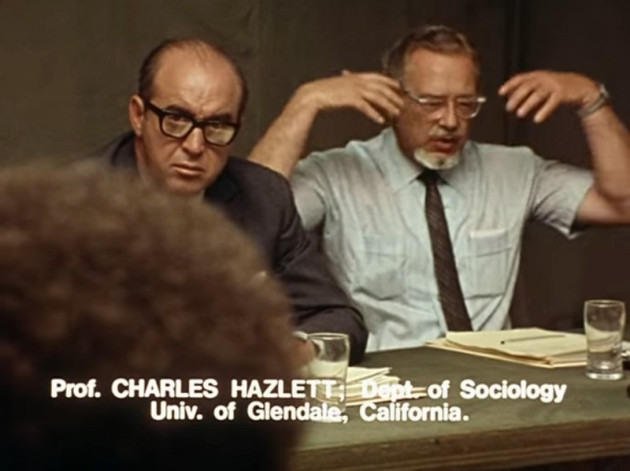
Tribunal “expert” witness
This film was initially meant to be a dramatized recreation of the trial of the Chicago Seven (later to be adapted into an easily marketable Hollywood film by Aaron Sorkin and released on Netflix in 2020) in the vein of his past mockumentary work. You can still see this in the themes, as well as the court hearing scenes that are closely related to the trial of the Chicago Seven. This version of the film got as far as the casting process before Watkins decided to make Punishment Park instead. He changed his mind because of the interactions he had with the non-professional actors (‘non-actors’), many of whom were actual activists demonstrating against the government’s abuse of power, and the horrifying life experiences that they shared with him. Watkins explains that the idea for the park itself came from learning about the anti-communist concentration camps that the American government was planning to create under the rule of Richard Nixon (Watkins video, around 5:30).
Mockumentary Techniques as a Warning
Before getting into the political meaning of this film, we must first acknowledge some of the post-documentary techniques that Watkins utilizes to grab the audience’s attention, beginning with the aforementioned non-professional actors. By this point in his career, Watkins “…had a deliberate policy in his films of using… non-professional, actors” as he felt this was the only way to achieve a feeling of realism (Cook, 229). This is evident in Punishment Park, since the actors both on the side of the activists and the court’s tribunal were shouting their true beliefs at each other (although the tribunal were told to play up their beliefs a little bit), making for much more realistic performances because, to some degree, the people were expressing their personal feelings. The fact that their arguments were real, as was their anger, drives the film forward. Watkins claims that the results he got from this were “for [his] money something [closer] to real life” (Cook, 229). Although the film is scripted, the bulk of the conversations are improvised, which contributes to the film’s documentary/mockumentary tone.

Young soldier as government pawn: death by innocence
Another technique that is normally reserved for documentary films is the constant breaking of the fourth wall. Throughout the film, there are many scenes in which the characters either look directly at the lens, as well as interviews in which the characters are directly addressing the camera. While this technique adds to the newsreel feel, it also works as a direct “invitation to the audience to enter the film itself, making a connection with their fellow members of the public,” in this case meaning the non-professional actors (Ibid., 232). This direct address to the camera, as when the tribunal members speak harshly to the prisoners, invites them to take action against the oppressors. It allows the audience a “greater level of identification and participation with [the] events taking place on-screen” despite them being purely fictional (Ibid, 232).
Another mockumentary technique that adds realism is the acknowledgment of the camera crew; the journalists are seen as being on the side of truth and therefore on the side of the prisoners. For the entirety of the film’s runtime Watkins places the camera crew right in the middle of the action. The crew watches as helpless prisoners are sent to the desert and murdered at the hands of the police or captured in a manner that breaks their own set laws. The fact that this crew is witnessing and documenting all the atrocities give the audience members a sense of relief. However, the final scene completely negates any sense of cathartic relief.
Unlike in Watkins’ previous mockumentaries, in which the narrator is removed from the events of the film, presumably recording his narration from the safety of a sound booth, this film places the narrator right in the action with the rest of the crew so that he has no choice but to be attached to the horror and form his/her own thoughts. In the final scene, we see one of the groups almost reach the flag in the middle of the desert park, but are stopped by police officers who were waiting for them. We then see the group of prisoners viciously beaten and murdered by unprovoked officers while we hear the narrator who is now far from the camera’s microphone yelling from a distance for the police to “stop it”. It is after this that we are given the warning. We see that the narrator is now afraid of the police as he yells “don’t you come near us” which is Watkins showing us that the press is not immune to the government’s brutal force. The police speak lies directly to the camera (the audience) as they attempt to justify their actions in a way that they believe the American people will accept, despite the footage saying otherwise, thus suppressing the truth. The scene (and film) ends with a close-up of the sergeant looking into the camera saying “this will happen again as long as we have this type of element to deal with.”
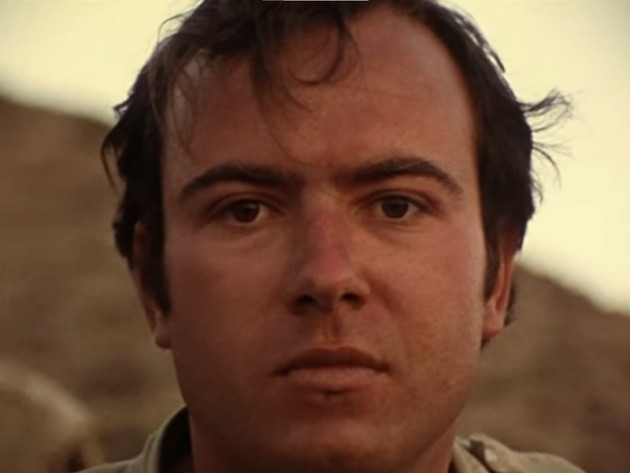
Last shot of the film
The journalist has failed, and the only thing left for him to do is “hold on to his evidence” in hopes of it being broadcast to the world (Kawin, 237). However, unlike Watkins’ older films in which the narrator is detached from the action which gives the sense that the documentary has already been edited and broadcast, this film ends with no guarantee that the atrocities will ever be shown to the people of this future timeline. The reality of this film has failed to be saved by the freedom and information of the press. It ends with an understanding that the police will continue to be unaffected by the meddling truth seekers as they are the ones in control (Cook, 232). It becomes truly disturbing when you connect this film to the age of the cell phone camera. The film’s themes are still relevant today, because we still see the arm of the government (police, military) disregarding video evidence and continuing to murder knowing that they will not be held accountable, while the activists and protestors are kidnapped from the streets by unmarked vehicles containing armed men. The government is safe. The people are not.
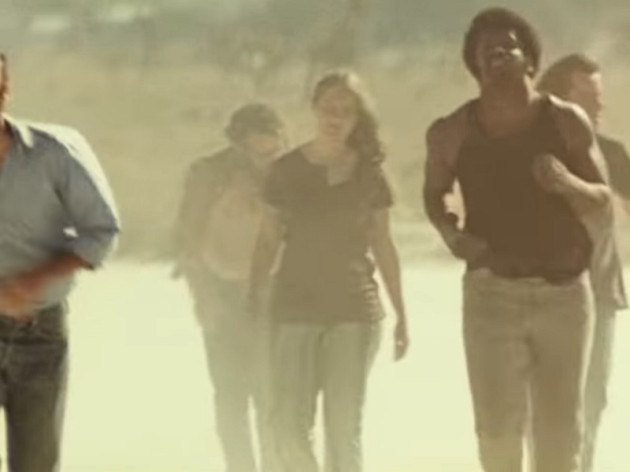
The illusion of escape in the desert
Watkins made a tragically bleak film in the hopes that “this sobering experience [would] act as a braking effect to the usual media portrayal of Western society as ‘happy’… with no need to worry about the future” (Watkins, 396). He used the mockumentary form to attempt to have realistic images and interactions so that people feel angry and compelled to stand up for their freedom rather than stay complacent toward their government’s wrongdoings.
Its Release
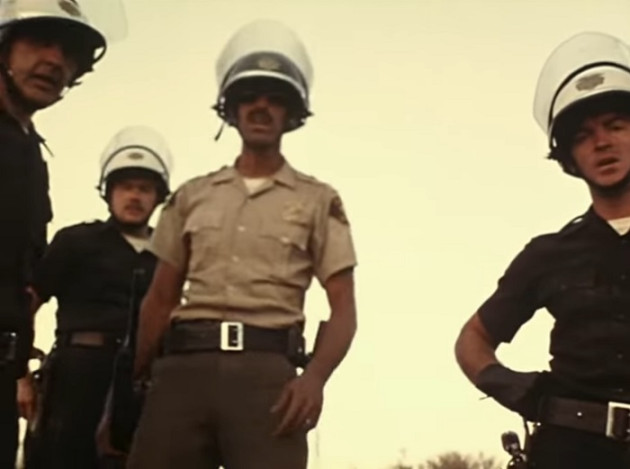
Low angle intimidation
Punishment Park was a commercial failure proving Watkins’ criticisms of the media to be true as they suppressed his pro-freedom message. “One of the most important strategies of critics is to blame a film for not being realistic enough” and that’s exactly what the critics did (Mavromatti, 1). The film was criticized for being too paranoid and the characters for being too obnoxious despite being real people stating their honest opinions. Calvin Green went as far as to call the activists “irate martyrs all dressed up in sacrificial raiment with no place to go” and to write “what can be said about a paranoid fantasy that delineates young radicals as ranting spastics” thus minimizing their impact, silencing the activist’s true opinions, and arguably siding with the conservative tribunal (Green, 1). The film was also suppressed by those in charge of the filmmaking system that Watkins opposed as it was refused much theatrical play and refused any distribution in America, proving Watkins right in that those in charge will always oppress that which they find to be a threat to their position (Watkins, 294). It is also important to note that for many years Punishment Park was hard to find theatrically (spare appearances at midnight screenings) or home video, until Eureka/Masters of Cinema released a Blu Ray/DVD combo set of the film in 2012 which is available as an Import to North America (and is region free). Otherwise it has yet to receive a widely available home video release in North America (though as of this writing the film was available on Youtube).
In Conclusion
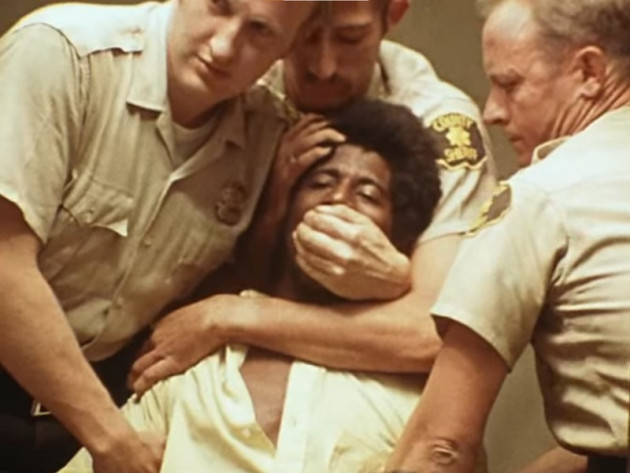
Police brutality
Peter Watkins’ film Punishment Park aimed to use the mockumentary film form as a manner of activism to get American audiences to see the possible direction their country was heading in. His intent in employing a newsreel style was to jar audiences enough that they would feel moved to remain vigilant to authority and if needed, be ready for political action. He did this by using documentary techniques such as casting non-professional actors, breaking the fourth wall, using free-form hand-held camera movements, staging direct-address interviews, and having the camera crew and journalists caught in the middle of the horror with the prisoners. The sentiment that the police will remain unaffected even if their atrocities are recorded was proven right when his own film was suppressed from the eyes of the public. Sadly, where police brutality is concerned, these concerns continue to come true more than five decades later.
Bibliography
Cook, John R. “‘Don’t Forget to Look into the Camera !’: Peter Watkins’ Approach to Acting with Facts.” Studies in Documentary Film, vol. 4, no. 3, 2010.
Green, Calvin. “Punishment Park.” Cinéaste, vol. 5, no. 2, 1972, pp. 31–32.
Kawin, Bruce F. “Peter Watkins: Cameraman at World’s End.” Journal of Popular Film, vol. 2, no. 3, 1973, pp. 231–242.
MacDonald, Scott. “Filmmaker as Global Circumnavigator: Peter Watkins’s The Journey and Media Critique.” Quarterly Review of Film & Video, vol. 14, no. 4, Aug. 1993, pp. 31–54.
Mavromatti, Oleg. “Post-Cinema Manifesti.” Oleg Mavromatti, olegmavromatti.com/contact/.
Watkins, Peter, director. Culloden. BBC, 1964.
Watkins, Peter, director. Peter Watkins on “Punishment Park”. YouTube, 2018, www.youtube.com/watch?v=jxb0ed9izis.
Watkins, Peter, director. Punishment Park. Churchill Films, 1971.
Watkins, Peter, director. The Forgotten Faces. Playcraft Film Unit, 1961.
Watkins, Peter. “Punishment Park and Dissent in the West.” Literature/Film Quarterly, vol. 4, no. 4, 1976, pp. 293–302.



